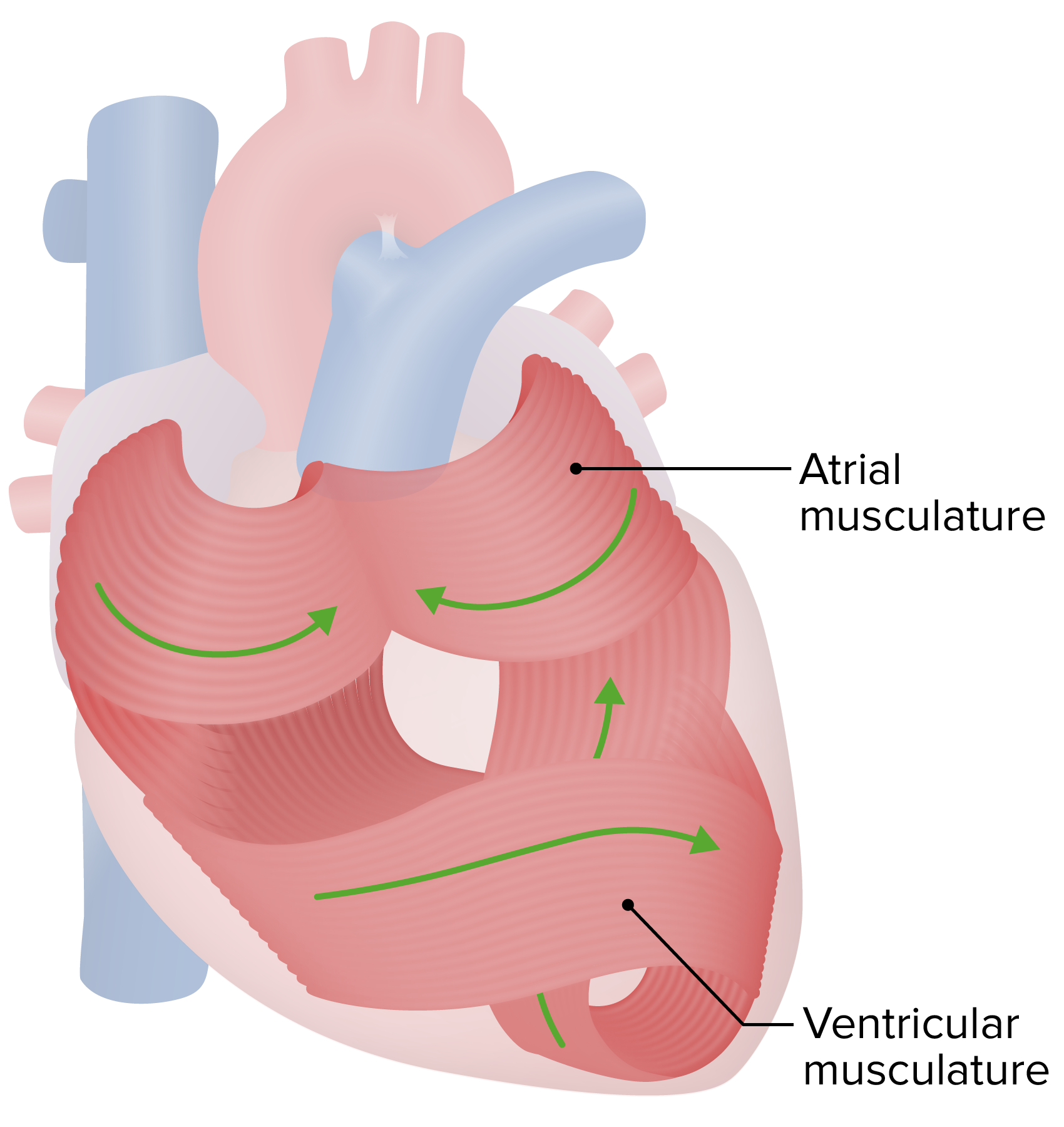Playlist
Show Playlist
Hide Playlist
Elements of the Heart: Chambers and Vessels
-
Slides Structure-Function Relationships Cardiovascular System.pdf
-
Reference List Pathology.pdf
-
Download Lecture Overview
00:01 Let's cut it in a slightly different way. 00:03 So this is a 4-chamber view, this is often the view that you will see on echocardiograms when you become expert clinicians. 00:11 This is a 4-chamber view, and we're looking at the anterior half of the heart. 00:14 So it's as if I cut myself this way through the heart. 00:18 And then I took off the anterior surface, and I presented it to you. 00:23 So the anterior surface of the heart here is showing you the right ventricle and the left ventricle as shown. 00:33 We have the interventricular septum in between. 00:36 The structure up there at the top is the tricuspid valve. 00:39 So that is bringing blood from the right atrium into the right ventricle. 00:44 And on the left hand side is the mitral valve, bringing blood from the left atrium into the left ventricle. 00:52 Let's look at a slightly different perspective, yet again, this is so that we can evaluate the valves and the circulation. 01:00 So this is looking down at the top of the heart on the right hand side. 01:05 And if we are looking down at the top of the heart, and we've cut off most of the vessels, we are looking at anteriorly the pulmonary artery. 01:12 In fact, the pulmonary artery is the most anterior great vessel coming off the heart. 01:17 Right behind it is the aorta. 01:21 Okay, and the aortic valve. 01:23 Now coming off the aortic valve is going to be the coronary arteries. 01:28 That's the right coronary artery, left coronary artery. 01:32 They're called coronaries, because someone thought the way that they look sitting off the top of the heart, they look like your crown. 01:39 So that's where the name 'corona', coronary came from. 01:45 The left coronary artery, the left main coronary artery branches into the left anterior descending and to the left circumflex artery. 01:52 And you can see that the vessels that are going to be the major epicardial coronary artery vessels are coming off the aorta on either side of the pulmonary artery. 02:03 Alright, so we're going to do a video here, looking at the various vessels and how they course around the heart and go to the various parts of the architecture. 02:13 We're going to emphasize again looking from base to apex, so base at the top, apex at the bottom. 02:19 First vessel that we see highlighted here is going to be the left main coronary artery coming off the left coronary os that's going to turn into the left circumflex as well as the left anterior descending. 02:34 Highlighted here is the right coronary artery, it's going to come off the right coronary os and course underneath the right atrial appendage, and you can see it as it winds its way around to the back of the heart, in the vast majority of us 90%, it's going to perfuse the posterior descending artery. 02:54 So that means that we are kind of perfusing the majority of the heart of the right ventricle in the posterior wall off the right coronary artery. 03:04 We can also see that there is a marginal branch that also got highlighted. 03:09 Now we're going to come back look at the left main coronary artery that is getting highlighted here. 03:15 That left main coronary artery is going to branch relatively quickly into the left anterior descending and the left circumflex artery. 03:25 And you see highlighted here, the left circumflex artery that courses underneath the left atrial appendage, and winds its way around laterally on to the left side of the heart. 03:36 This is going to be responsible for perfusing the lateral wall of the heart predominantly. 03:42 There are going to be a number of vessels that branch off that— those are the marginals. 03:46 Now we're looking at the left anterior descending the branches to come off it are the diagonals. 03:51 And as we tip up onto the apex of the heart, you can see how the left anterior descending and the right coronary artery meet down there at the apex- a watershed zone. 04:02 We're looking now at the left circumflex and its marginal branches and there will be the diagonal branches that are coming off the left anterior descending. 04:13 Between the left circumflex and the right coronary artery is another watershed zone. 04:19 And this on the kind of posterior lateral aspect of the left ventricle is another zone where there's collateralization between the right and the left circulation.
About the Lecture
The lecture Elements of the Heart: Chambers and Vessels by Richard Mitchell, MD, PhD is from the course Structure-Function Relationships in the Cardiovascular System.
Included Quiz Questions
Which great vessel of the heart is in the most anterior location?
- The pulmonary artery
- The aorta
- The left pulmonary vein
- The inferior vena cava
- The superior vena cava
Which of the following vessels travels under the left atrial appendage to give blood supply to the lateral portion of the heart?
- The left circumflex artery
- The left main coronary artery
- The left anterior descending
- The right coronary artery
- The posterior descending artery
While performing an echocardiogram, a cardiologist sees a regurgitant jet from the left ventricle to the left atrium. Which of the following structures is most likely diseased?
- The mitral valve
- The aortic valve
- The left coronary os
- The tricuspid valve
- The right coronary os
Which of the following describes a significant difference between the tricuspid valve and the mitral valve?
- The tricuspid valve has three leaflets, while the mitral valve has only two.
- The tricuspid valve is an atrioventricular valve, while the mitral valve is a semilunar valve.
- The tricuspid valve attaches to the ventricular papillary muscle via chordae tendineae, while the mitral valve attaches via the tunica intima.
- The tricuspid valve separates the right atrium from the right ventricle, while the mitral valve separates the right ventricle from the pulmonary artery.
- The tricuspid valve tends to become diseased more often than the mitral valve.
On an echocardiogram, you can see the tip of a right internal jugular central venous catheter in the right atrium. Which vessel enters the right atrium from the cranial direction?
- The superior vena cava
- The inferior vena cava
- The pulmonary artery
- The left pulmonary vein
- The aorta
An interventional cardiologist plans to put a stent in the vessel that supplies the lateral portion of the left ventricle. Which of the following is the correct order of structures they would pass the catheter through?
- Aorta - left main coronary artery - left circumflex artery
- Aorta - left main coronary artery - left anterior descending artery
- Pulmonary artery - right coronary artery - posterior descending artery
- Aorta - right coronary artery - posterior descending artery
- Aorta - right main coronary artery - right circumflex artery
Customer reviews
5,0 of 5 stars
| 5 Stars |
|
5 |
| 4 Stars |
|
0 |
| 3 Stars |
|
0 |
| 2 Stars |
|
0 |
| 1 Star |
|
0 |




